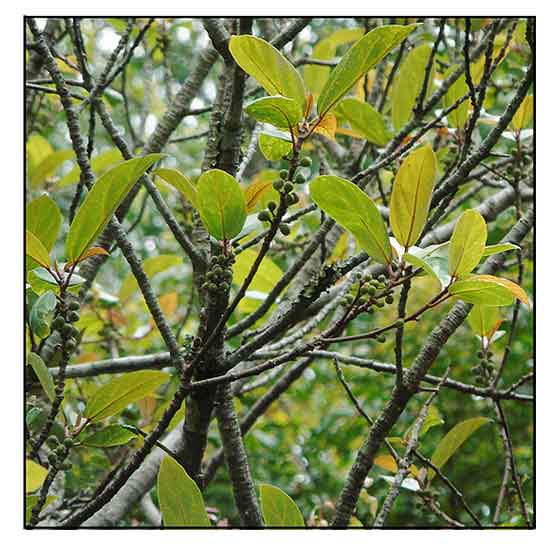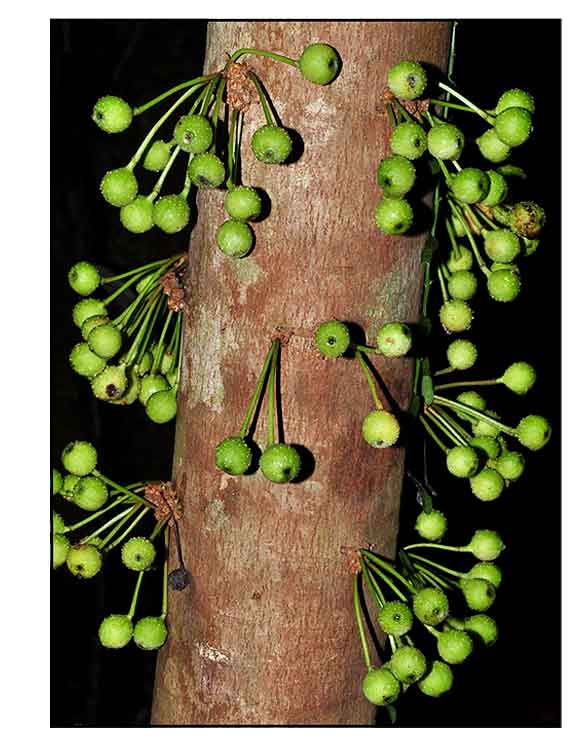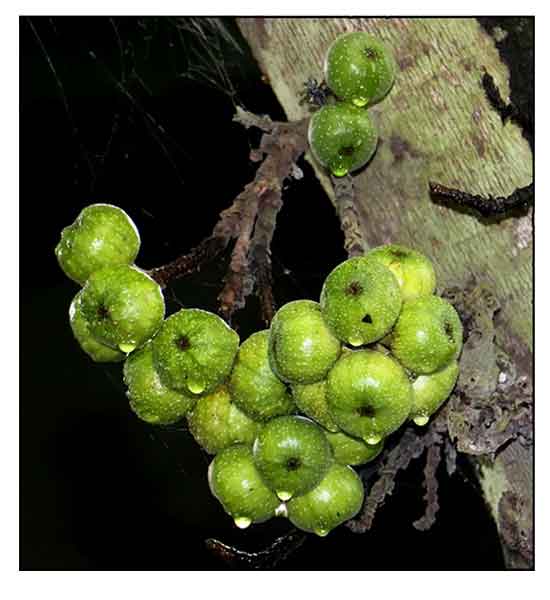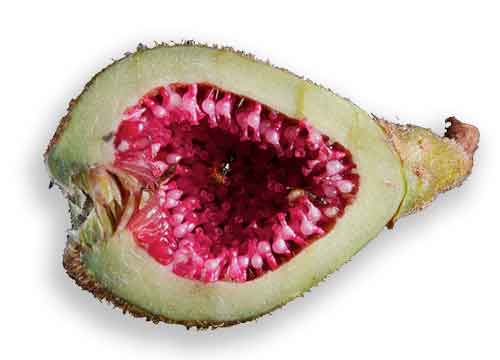 Gen info Gen info
- Ficus is a genus of about 850 species of woody trees, shrubs, vines, epiphytes, and hemiepiphytes in the family Moraceae. They are collectively known as fig trees or figs. (15)
- Molecular clock estimates indicate Ficus is a relatively ancient genus at least 60 million years old, possibly as old as 80 million years. (15)
-
Ficus fistulosa is an Asian species of fig tree in the family Moraceae.
- Etymology: The genus name Ficus is Latin for fig tree. The specific epithet fistulosa derives from Latin fistulosus, meaning "hollow throughout," referring to the hollow twigs.
- The fruit of the ficus is an inflorescence enclosed in an urn-like structure called synconium, which is lined on the inside with the fig;s tiny flowers that develop into multiple ovaries on the inside surface. In essence, the fig fruit is a fleshy stem with multiple flowers that fruit and coalesce.
(15)
Botany
• A tree reaching up to 18 m tall, containing white latex, with hollow young twigs, and figs borne on its trunk. Foliage: Spirally arranged, stalked leaves have somewhat leathery leaf blades that are oval to drop-shaped, dark green, 4–34 by 1.5–17 cm, and with lightly toothed or wavy margins. Flowers: The plant is dioecious with each plant bearing male or female flowers. The flowers are tiny and develop within the syconium. Fruit: Syconia (figs) are found in clusters at the leaf-axils or on trunks and branches, and are somewhat round to pear-shaped, slightly rough on the surface, green with white dots then pale to greenish yellow when mature, and 1–4 cm wide. (2)
 • Small trees, evergreen; dioecious. Bark dark brown. Branchlets hispid. Stipules ovate-lanceolate, 1-2 cm. Leaves alternate; petiole (0.7-)1.5-4 cm; hispid or hirsute; leaf blade obovate to oblong, 10-20 × 4-8 cm, papery, abaxially sparsely pubescent or yellow tuberculate, adaxially glabrous, base obliquely cuneate to rounded, margin entire or undulate, apex mucronate; basal lateral veins short, secondary veins 6-9 on each side of midvein. Figs on short ± conic branchlets on main branches, reddish orange when mature, ± globose, 1.5-2 × 1.5-2.2 cm, subglabrous, smooth, apical pore not open; peduncle (0.5-)0.8-2.4 cm. Male flowers: few, near apical pore, shortly pedicellate; calyx lobes 3 or 4; stamen 1; filament short. Gall flowers: pedicellate; calyx lobes very short or absent; ovary obovate, smooth; style ± lateral, thin; stigma enlarged. Female flowers: perianth tubular, enclosing base of pedicel; style persistent, long, clavate. Achenes obliquely cubic, with small tubercles. (Flora of China) • Small trees, evergreen; dioecious. Bark dark brown. Branchlets hispid. Stipules ovate-lanceolate, 1-2 cm. Leaves alternate; petiole (0.7-)1.5-4 cm; hispid or hirsute; leaf blade obovate to oblong, 10-20 × 4-8 cm, papery, abaxially sparsely pubescent or yellow tuberculate, adaxially glabrous, base obliquely cuneate to rounded, margin entire or undulate, apex mucronate; basal lateral veins short, secondary veins 6-9 on each side of midvein. Figs on short ± conic branchlets on main branches, reddish orange when mature, ± globose, 1.5-2 × 1.5-2.2 cm, subglabrous, smooth, apical pore not open; peduncle (0.5-)0.8-2.4 cm. Male flowers: few, near apical pore, shortly pedicellate; calyx lobes 3 or 4; stamen 1; filament short. Gall flowers: pedicellate; calyx lobes very short or absent; ovary obovate, smooth; style ± lateral, thin; stigma enlarged. Female flowers: perianth tubular, enclosing base of pedicel; style persistent, long, clavate. Achenes obliquely cubic, with small tubercles. (Flora of China)
Distribution
- Native to the Philippines. (1)
- In forests up to 2000 m.
- Also native to Andaman Is., Assam, Bangladesh, Borneo, Cambodia, China South-Central, China Southeast, East Himalaya, Hainan, India, Jawa, Laos, Lesser Sunda Is., Malaya, Myanmar, New Guinea, Nicobar Is., Sulawesi, Sumatera, Taiwan, Thailand, Vietnam. (1)
 Constituents Constituents
- Phytochemical screening of leaves extracts yielded tannins +, alkaloids ++, reducing sugar +, with absence of saponins, glycoside, and gum. (see study below) (3)
- Study isolated two triterpenoids, 3β-acetyl ursa-14:15-en-16-one and lanosterol-11-one acetate, along with five known triterpenoids, 3β-acetyl-22,23,24,25,26,27-hexanordamaran-20-one, 24-methylene-cycloartenol, sorghumol (isoarborinol), 11α,12α-oxidotaraxeryl acetate, and ursa-9(11):12-dien-3β-ol acetate. (5)
- Study of bark and leaves isolated two new septicine-type alkaloids, fistulopsines A and B (1,2), together with four known phenanthroindolizidine alkaloids (+)-septicine, (+)-tylophorine, (+)-tylocrebrine, and (–)-3,6-didemethylisotylocrebrine) and (+)-(6S,9S)-vomifoliol. (see study below) (7)
- Study of 95% ethanol extract of leaves isolated five alkaloids, two alkaloids, (+)-tengerensine (1) and (+)-tengechlorenine (2), along with )-fistulosine (3) a benzopyrroloisoquinoline alkaloid, (S)-(+)-antofine (4) a phenanthroindolizidine alkaloid, and (R)-()-secoantofine (5) a septicine-type alkaloid. (see study below) (9)
- Bioassay-directed fractionation of dried leaves and stem barks led to the isolation of verrucarin L acetate (1), together with 3α-hydroxyisohop-22(29)-en-24-oic acid, 3β-gluco-sitosterol, 3,4-dihydro-6,7-dimethoxyisocarbostyril, 3,4,5-trimethoxybenzyl alcohol, α-methyl-3,4,5-trimethoxybenzyl alcohol, indole-3-carboxaldehyde, palmanine, and aurantiamide acetate. (see study below) (11)
- Study of stem bark of F. fistulosa isolated a new benzopyrroloisoquinoline alkaloid, fistulosine (1), along with three known phenanthroindolizidine alkaloids, (−)-13aα-antofine (2), (−)-14β-hydroxyantofine (3) and (−)-13aα-secoantofine (4). (see study below) (13)
Properties
- Plant considered diaphoretic.
-
Studies have suggested antibacterial, antioxidant, anti-HIV, anti-Hepatitis C, antiproliferative, anticancer, antifungal, antimalarial properties.
Parts used
Leaves, roots, latex.
 Uses Uses
Edibility
- Young leaves and synconia eaten in salads.
- A drink is made from the leaves.
Folkloric
- In Albay, Philippines, crushed leaves applied on insect bites. (12)
-
Elsewhere, used for treatment of diabetes, diarrhea, malaria, fever, rashes, eczema.
- Decoction of root drunk after childbirth. Latex used with other herbs as poultice for headaches. (2)
- Mature leaves used as narcotic; smoked with opium. (14)
- In India, use for post-natal treatment.
Others
- Wood: Low quality timber. Used for temporary construction, mouldings, interior work, cladding, drawers, laundry tubs, fruit crates, floats. (14)
Studies
• Antimicrobial / Antioxidant / Leaves: Study evaluated leaves extracts of Ficus fistulosa for antimicrobial using disc diffusion studies against Bacillus subtilis, Staphylococcus aureus, Pseudomonas aeruginosa, E. coli, and E. coli mutant. The aqueous extract showed inhibitory activity at 0.4 mg/well concentration against all bacterial strains. The methanol extract showed promising DPPH free radical scavenging activity with IC50 of 16.66 µg/ml. Percent scavenging rose with increasing concentration. (see constituents above) (3)
• Anti-HIV Activities / Leaves: Because of the high prevalence of HIV drug-resistant strains, there is a demand for novel antiviral drugs, especially via herbal medicine approach. Study evaluated an ethanol extract and fractions of Ficus fistulosa leaves for inhibitory activity on HIV replication using cytotoxicity assays and syncytium formation. The chloroform fraction of leaves effectively inhibited MT4/HIV cell proliferation with toxicity at a minimum level (IC50 3.27 µg/mL, CC50 29.30 µg/mL, and SI 8.96). In contrast, the ethanol extract showed weak inhibition with high level of toxicity (IC50 8.96 µg/ml, CC50 ≥50µg/ml, and SI 5.58). (4)
• Anti-Hepatitis C Virus / Leaves: Study evaluated Ficus fistulosa leaves extracts (FFL) and fractions for anti-HCV activities by cell culture method using Huh7it cells and HCV JFH1a. Results showed the ethanol extract inhibited HCV JFH1a with IC50 of 20.43 µg/ml. The extract was not toxic with CC50 of >200 µg/ml. A chloroform fraction anti-HCV activity with IC50 of 5.67 µg/mL and CC50 >100 µg/ml (Selectivity index > 17.65). Two subfractions (FFLC10 and FFLC11) showed high selectivity index (>100) with IC50s of 0.60 µg/ml and 0.43 µg/ml, respectively. Results suggest the leaf extract (FFL) and fractions (FFL10, FFL11) are potential candidates for antiviral development against HCV. (6)
• Fistulopsines / Antiproliferative / Bark and Leaves: Study of bark and leaves isolated two new septicine-type alkaloids, fistulopsines A and B (1,2), together with four known phenanthroindolizidine alkaloids (+)-septicine, (+)-tylophorine, (+)-tylocrebrine, and (–)-3,6-didemethylisotylocrebrine) and (+)-(6S,9S)-vomifoliol. Fistulopsines A and B showed invitro growth inhibitory activities in HCT116 and MCF7 cell lines with GI50 ranging between 2-7µM. Compounds 1 and 2 also predominantly arrested cells in G1 phase of the cell cycle without induction of apoptosis. (7)
• Management of Seborrhea and Sebum / Cosmeceutical Potential / Fruit: Study evaluated the efficacy of a hydrogel containing F. fistulosa extract for controlling sebum. Safety was evaluated in volunt3eers using a closed patch test. The extract contained 0.0359 mg of tannic acid equivalent per gram of extract, and astringent activity of 87.45%. The hydrogel containing 0.1% w/w showed highest stability profile. No irritation or allergy was observed. Twice daily use for 28 days showed sebum content decrease by 54.36%. Results suggest the fruit extract may be an effective ingredient for cosmeceutical use. (8)
• Cytotoxic Alkaloids / Leaves: Study of 95% ethanol extract of leaves isolated five alkaloids, two alkaloids, (+)-tengerensine (1) and (+)-tengechlorenine (2), along with three known alkaloids. (+)-Tengerensine 1 exhibited selective cytotoxic effect against MDA-MB-468 cells (IC50 7.4 µM). (9)
• HIV Inhibition of Replication: An n-hexane fraction of a methanol extract showed active inhibition to HIV replication without toxicity to healthy cells (IC50 27.2 µg/mL, CC50 377.9 µg/ml, SI=13.8). Further fractionation was suggested to separate the active compound. (10)
• Trichothecene Verrucarin / Antimalarial / Leaves and Stem Barks: Bioassay-directed fractionation of dried leaves and stem barks led to the isolation of verrucarin L acetate (1), together with 3α-hydroxyisohop-22(29)-en-24-oic acid, 3β-gluco-sitosterol, 3,4-dihydro-6,7-dimethoxyisocarbostyril, 3,4,5-trimethoxybenzyl alcohol, α-methyl-3,4,5-trimethoxybenzyl alcohol, indole-3-carboxaldehyde, palmanine, and aurantiamide acetate. Verrucarin L acetate was characterized as macrocyclic trichotehcene sesquiterpenoids and was found to inhibit the growth of Plasmodium falciparum with IC50 below 1 ng/ml. (11)
• Benzopyrroloisoquinoline Alkaloid / Antifungal / Stem Bark: Study of stem bark of F. fistulosa isolated a new benzopyrroloisoquinoline alkaloid, fistulosine (1), along with three known phenanthroindolizidine alkaloids, (−)-13aα-antofine (2), (−)-14β-hydroxyantofine (3) and (−)-13aα-secoantofine (4). Compound 2 exhibited antifungal activity against Aspergillus fumigatus and Candida albicans. (13)
Availability
Wild-crafted.
|

![]()







